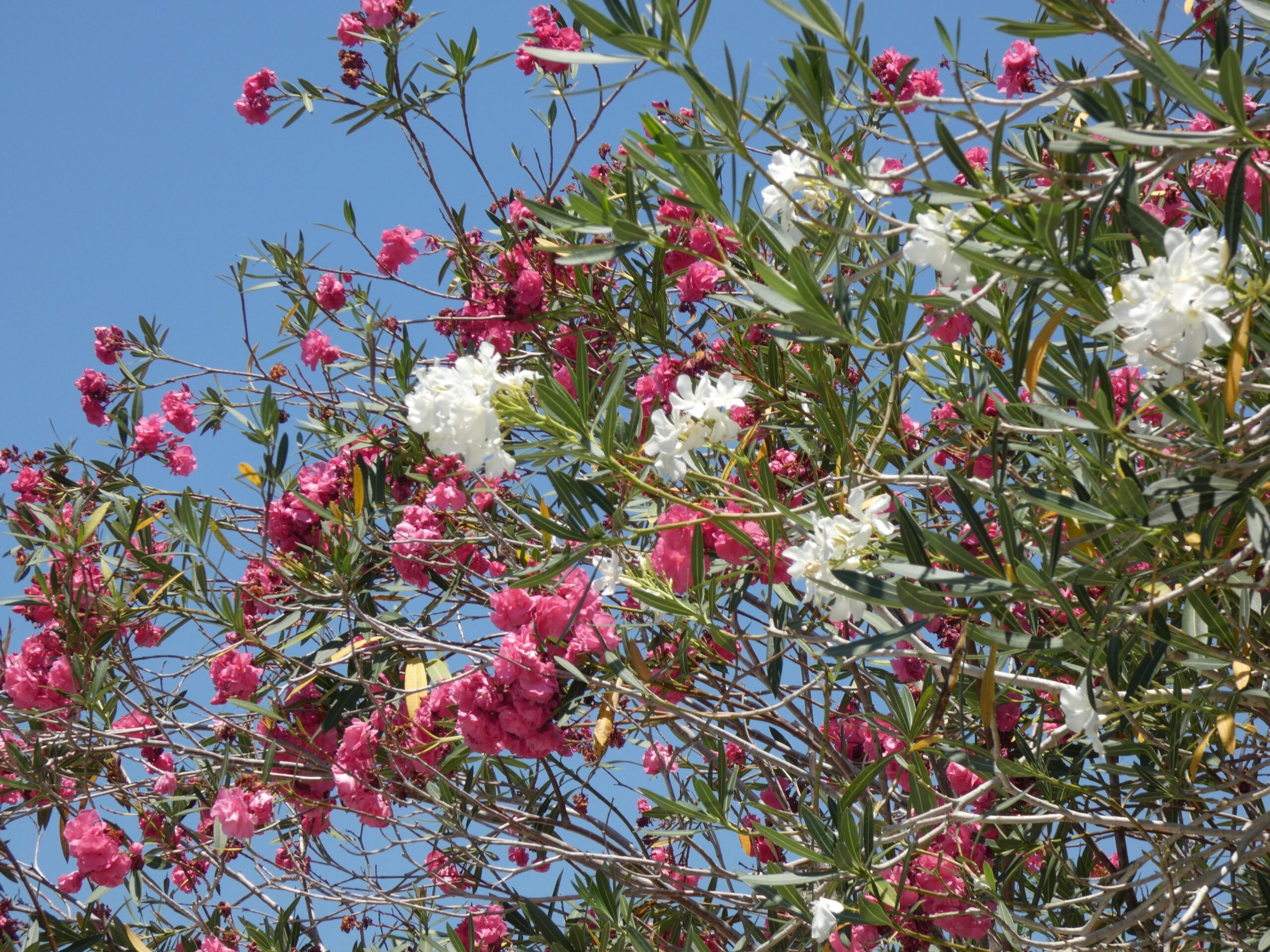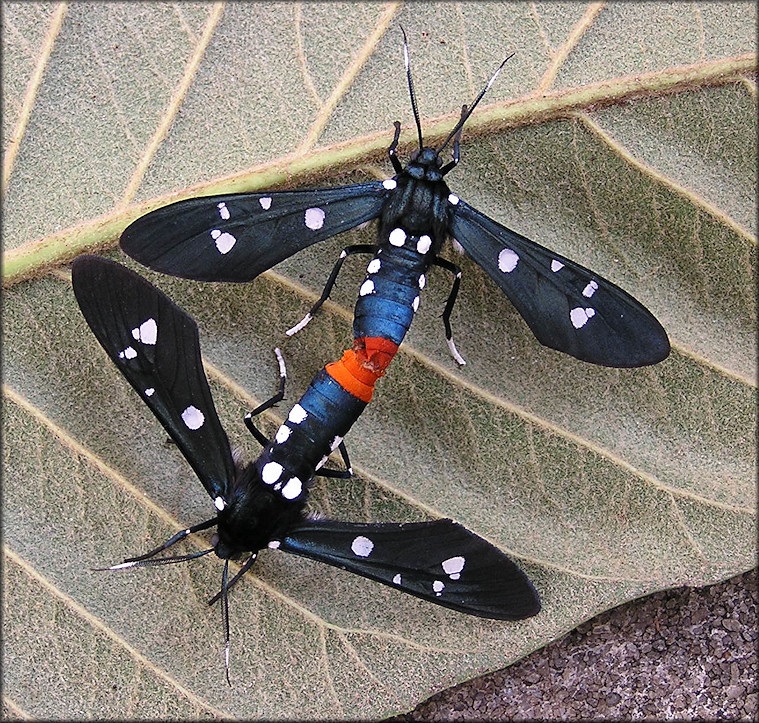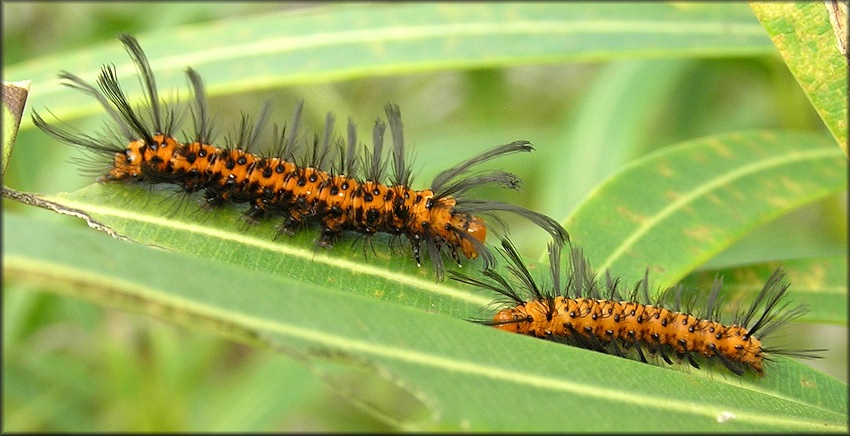
VISITORS TO THE ESTATES CAN FIND BOTH PINK AND WHITE OLEANDER BLOOMS
Edison’s Oleander
Thomas Edison had many research beds on the south side of the property, teemed with goldenrod, rubber vine and crown-of-thorns. These, and more, were planted in the late 1920s-1930s by the Edison Botanic Research Corporation and were tested for latex content.
At one time, there were at least 160 beds, each measuring five feet by 20 feet. Prior to the exuberant research done for domestic tire rubber, Edison, the chemist, explored many plants for other uses. In addition to his filament research, Edison sought a way to insulate wire, something important to Henry Ford’s work.
Amongst the many euphorbias and Ficus, another latex-bearing plant was considered – the oleander. Historical purchase records indicate that Edison purchased oleander as early as 1909 from the Tampa Floral Company. A little-known piece of Edison’s work history in Fort Myers included his efforts to develop a machine to strip the leaves off oleander branches. His efforts produced a machine that stripped 20,000 plants in eight hours, which he deemed too slow, failing to meet his own goal of 160,000 plants in eight hours – and thus he abandoned this project.
Oleander is the only species in the genus Nerium, part of the Apocynaceae or Dogbane family of plants, which includes plumeria, desert rose and Madagascar periwinkle. Interestingly, the extensive plumeria collection occupies part of the original research bed site. In addition to all exuding latex, they share another characteristic that will be discussed later in this article.
This is the time of year – through to autumn – when oleanders punctuate colorful summer landscapes, complimenting royal poincianas and crape myrtles. The University of Florida (IFAS) information sheet on oleander calls out the “bad girl reputation” of this easy-care shrub but makes the case for thoughtful inclusion in a Southwest Florida garden.
Before going further, I want to address the well-known issue of toxicity of oleander. Nerium comes from an ancient Greek word for water, where they naturally grow along rivers and streams. Oleander is a modern derivation from ancient Greek, meaning “to kill.” In the shadow of Mt. Vesuvius, close to Naples, Italy, the tree is called “Fiori di Morto” (flower of the dead). All parts of this shrub or small tree are considered toxic to humans and domestic animals, though apparently not so to rodents. But, to provide context, over 90% of ornamental plants are irritating, if not toxic, to humans and pets. The actual number of deaths from ingesting oleander is very low in the U.S. and perhaps that is a credit to the awareness most people have of its toxicity.

WILL EAT THE LEAVES BUT WILL NOT KILL THE PLANT.
Some people have even expressed concern that honey made from oleander contains toxins. Though pollination of oleander flowers requires the assistance of insects to set seed, their flowers, in fact, do not contain any nectar, thereby eliminating this concern.
In ancient Greece, the oracle of Delphi, a high priestess known as Pythia was remembered for her divine frenzies, purportedly brought about by ingesting bay laurel. Researchers have since realized that oleander was at one time called laurel, but the bay laurel that grows alongside the oleander does not harm humans, leading to the conclusion that Pythia was probably ingesting oleander, which induced her inspired epiphanies.
For the reasons they flourish in the Mediterranean region, perhaps oleander has a home in your Southwest Florida landscape. Fast growing, these hardy, evergreen trees will not annoy the tidy gardener with messy leaf drop. They love full sun and will tolerate a small amount of shade. While regular watering will improve bloom production, they are quite capable of thriving during extensive periods of drought and can handle almost any well-drained soil. Of note, is their salt tolerance, making them a colorful choice for coastal landscapes.
Should temperatures plunge into the 20s, oleander may die back; however, given time, the roots will soon resprout new growth. Oleanders take well to pruning after flowering to maintain either their height or a nice shape to prevent them from becoming leggy.


THE OLEANDER MOTH HAS VERY VIBRANT COLORS. THE CATERPILLARS LOOK SIMILAR TO THE GULF FRITILLARY CATERPILLARS.
Today, there are more than 400 hybrids of oleander, including single flowers, double flowers, fragrant and dwarf varieties, such as ‘Petite Pink,’ which is planted in the median strip on McGregor Boulevard, between both sides of the Estates. Oleander was introduced to the US in 1841 through Galveston, Texas and the Oleander City still celebrates that heritage with an annual festival in April.
In addition to Edison’s interest in the botanic elements of oleander, it was also planted as part of the dense landscape surrounding the Ford home. Given its size, it was probably already there when Mr. Ford purchased the home in 1916. Today, one can view the collection of Nerium oleander that graces the Ford property, along the McGregor fence line, which includes single white flowers and a double pink, “Mrs. Isadora Dyer.”
What are good companion plants for oleander? As a native of the Mediterranean, comparable foliage that enjoy full sun, well-draining soil and are somewhat drought tolerant would include rosemary, lantana, yarrow, and agapanthus. Marigolds will do well for winter or spring color and may aid in repelling oleander moth caterpillars.
When an insect is named after a plant, that’s an important indication of the plant being a host. Earlier in this article, I referenced a characteristic that the oleander tree shares with its botanical cousins. It’s this little bugger – the caterpillar of the Oleander Moth, sometimes called the Uncle Sam Moth due to its color pattern. The orange caterpillar with black hairs can easily be mistaken for the Gulf Fritillary caterpillar if one doesn’t realize that it’s the wrong host plant. The Oleander Moth also will host on desert roses (Adenium), plumeria (Plumeria) and periwinkles (Catharanthus) – all members of the Dogbane family.
As an aside, a second oleander is noted in the historical records of plants grown on the Edison property. Not a true oleander, records identify the plant as oleander (Thevita neriifolia), though today its botanical name is Cascabela thevetia. With beautiful starburst like foliage, the lucky nut appears throughout the Estates and, again like the other members of the Dogbane family, it is as poisonous as its oleander cousin. The lucky nut only has yellow flowers, generating its other common name of yellow oleander.
The Garden Shoppe staff at the Estates are always happy to help answer any questions that visitors may have. We hope to see you soon!






